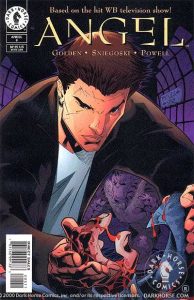Since Tom Sniegoski joined Christopher Golden as a co-writer, and once Wesley joined Angel and Cordelia in the crime-solving trio, the “Angel” comic hit its stride. The back half of the Season 1 comics would turn out to also be the back half of the entire first volume from Dark Horse, as Joss Whedon – working on “Fray” at the time — put a halt to the title in order to reboot it as a superhero-styled comic (which ended up lasting only four issues). While there would be a lot more “Angel” comics through the years, particularly from IDW, Dark Horse’s “vintage” era ended too soon.
“Beneath the Surface” (Issues 8-9, June-July 2000)
Colorist Lee Loughridge is a secret weapon in the Wesley-era issues, as he provides a dark noir feel, starting with an opening panel of a sunrise over Los Angeles that then cuts to Angel entering the dark sewers. Golden never seemed comfortable with the Angel-Cordy-Doyle dynamic, but he and Sniegoski are in an immediate groove with the new setup: Angel brooding, Wes bumbling and Cordy complaining about the job despite always being there when needed.
Kate prominently enters the fold as a hardboiled LAPD detective, with her colleagues essentially telling her she looks like hell in her opening crime-scene visit (under Eric Powell’s pen, she doesn’t). Still in her period of not quite trusting Angel, Kate pegs him as a suspect in a series of killings and aims to trap him by blocking off sewer-tunnel exits. This is early in the “not all monsters are bad” portion of the saga – soon after half-demon Doyle’s death – and we meet the innocent sewer-dwelling Abner, an answer to “Batman’s” Solomon Grundy.
4 stars
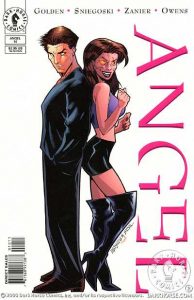
“Strange Bedfellows” (Issues 10-11, August-September 2001)
This crackling tale – with Christian Zanier back on pencil duties — explores a vampire brothel, something that was introduced into Sunnydale in “Buffy” Season 5 in the Fall of Riley arc but which makes more sense in the City of Angels. There’s more comedy this time around as a flustered and terrified Wesley waits in the lobby while Angel talks with the house’s madam.
But it gets quite grim when we see a bedraggled Candy — the vampire prostitute who drained her client, kicking off this case – subsisting on rats in a storage garage. Angel loses no sleep over staking an informant and later serving up Candy to the police, where she will “spontaneously combust” at a news conference in the daylight. His behavior is a sneak preview of the “dark Angel” period of Season 2, when he pushes the boundaries of a given case to punish whatever creatures of the night are in his path.
4 stars
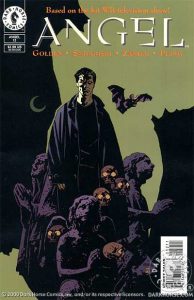
“Vermin” (Issues 12-13, October-November 2001)
This is a wonderful entry as part of Dark Horse’s “Autumnals” theme, where the company aimed to go a bit darker with its comics. Like the other tales in this batch, it’s not a twist-filled mystery, but I rank it a cut above because it seems so personal to Angel: He hates rats, and we see flashbacks to his lost century, where he’s covered in rats while trying to sleep in an alley. And as Wes explains to Cordy: “For a number of years, rats comprised the lion’s share of his diet.”

The abandoned theme park, like something out of “Batman,” is an evocative setting, and the implication that one of the kidnappers plans to rape their young captive is a nod to the “Autumnals” theme. Despite Angel’s reassurances to Ashley that he’ll see her safely out of the park (deliciously, he has no interest in rescuing the kidnappers), he’s bombarded by mutant rats, as if he has stumbled into Stephen King’s “Graveyard Shift.” Angel clutching an innocent girl while fighting off vermin in full vamp-face nicely boils down his mission into a single image.
4.5 stars
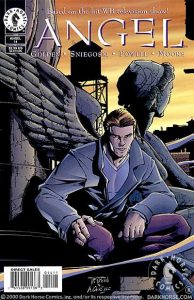
“Little Girl Lost” (Issue 14, December 2000)
Again on a King riff, the titular girl here is more or less Drew Barrymore’s character from “Firestarter.” Angel figures out how to end her curse, which was placed on her by an over-the-top wicked stepfather. The issue looks great, with Jason Moore inking Powell’s pencils, but less thought is put into the story, with Angel barging into a house without being invited at one point. Gunn and his gang make a cameo – their first appearance in the comics – placing this issue near the very end of Season 1, after “War Zone” (1.20).
3.5 stars
(Click here for my reviews of Issues 15-16, part of a crossover with “Buffy.”)
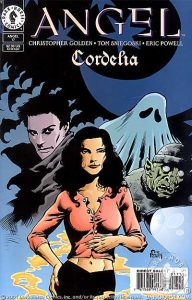
“Cordelia” (Issue 17, April 2001)
The final installment of “Angel” Volume 1 is a light-hearted spiritual sequel to “Rm w/a Vu” (1.5), in which Cordy acquires the apartment where she will cohabitate with the good ghost Dennis. Due to special effects limitations, we are only rarely reminded of Dennis through the rest of the TV series, but he gets a showcase issue here.
Set soon after “To Shanshu in L.A.” (1.22), when the Angel Investigations offices get blown up, “Cordelia” finds the title character guarding an important item while Angel and Wes go off to kill the demon it belongs to. But a hench-demon invades Cordy’s apartment to get the item, and Dennis – having protectively locked an annoyed Cordy in her room – fights off the intruder like the loyal roommate he is.
3.5 stars
Click here for an index of all of John’s “Buffy” and “Angel” reviews.

